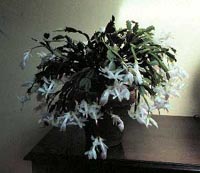Resource Library
Plant of the Week: Thanksgiving Cactus | Holiday Cactus, Christmas Cactus |History and tips for growing a Christmas Cactus
The University of Arkansas System Division of Agriculture does not promote, support or recommend plants featured in "Plant of the Week." Please consult your local Extension office for plants suitable for your region.
Plant of the Week
Holiday Cactus, Christmas Cactus, Thanksgiving Cactus
Latin: Schlumbergera truncata

Cacti have always fascinated me. Most gardeners aren’t so fascinated. In fact, many turn downright belligerent when you even bring up these spiny little creatures. But even the most ardent cactus-hater surely must delight when the delicate flowers of the Thanksgiving cactus appear in early fall.
Origin and history
You might think that the Thanksgiving cactus would come from the desert areas of the New World, but it actually inhabits the tree tops of southern Brazil, sharing its space with orchids and bromeliads.
Thanksgiving cactus is a true cactus, but it lacks the spines and the round, chubby little body normally associated with members of their plant family. It produces flat, segmented leaf-like branches called cladophylls. The branches are edged with long, serrated teeth.
The showy multi-petaled flowers come in shades of pink, rose, red, white and even yellow. They appear from mid-November until after Christmas.
This group of flowering cacti was originally hybridized by William Buckley in Rio de Janeiro about 1840. The genus was named after a Belgian horticulturist, Frederick Schlumberger. Schlumbergera are hybrids and have slightly different blooming times. If a particular plant blooms in November, it’s a ‘Thanksgiving’ cactus. If it blooms around the end of the year, it becomes a ‘Christmas’ cactus, even though it is not the true Christmas cactus.
The true Christmas cactus, Schlumbergera x buckleyi, differs from S. truncata. The S. Truncata has an asymmetrical flower and wings on its ovary.
The common names associated with American holidays, or even Christian holidays, have limited meaning to the rest of the world. In Europe, this cactus is called ‘Crab cactus.’ The Europeans have never caught on to the turkey and cranberry idea. In its native Brazil, even ‘Christmas cactus’ is meaningless because the plants flower during April and May, the normal fall season of the Southern Hemisphere.
How do I get my Thanksgiving cactus to flower?
The initiation of flower buds on the Thanksgiving cactus is triggered by both temperature and day length, i.e., short days of fall. If the temperature is lower than 60 degrees, plants set flower buds regardless of the length of the day or night. If the temperature is more moderate, plants show a classic short-day response. They initiate blooms as the days get shorter in the fall.
Thanksgiving cactus has a 12-hour critical night length, meaning if it receives more than 12 hours of light in a day, it will not bloom. The vernal equinox occurs on Sept. 21, so all days after that date have less than 12 hours of light, which triggers trigger flowering. Plants also respond to the cooler days. After exposure to either cool temperatures or short days for six weeks, flower buds will appear.
One of the recommendations often found in older books discussing this species is the practice of giving a "dry-down" treatment in the early fall to encourage good bloom set. A number of researchers have looked at this practice and found it actually decreases bloom numbers. On average, the number of blooms per cladophyll was 2.5 for plants kept uniformly moist and 1.5 for plants exposed to a dry-down treatment.
How do I care for my Thanksgiving cactus?
The Thanksgiving cactus should have a good, well-drained potting media. It’s best kept somewhat confined, so only transplant the plants to a larger pot about every other year. As the blooms develop, give the plant a good sunny window and keep it uniformly moist. In the summer, move the pot to the patio and put it where it has a bit of shade during the hottest part of the day.
By: Gerald Klingaman, retired
Extension Horticulturist - Ornamentals
Extension News - October 20, 2000
The University of Arkansas System Division of Agriculture does not maintain lists of retail outlets where these plants can be purchased. Please check your local nursery or other retail outlets to ask about the availability of these plants for your growing area.